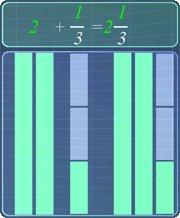Examples on How to Add Fractions
Lesson Objective
In this lesson, we will see a few more examples on how to add fractions...
About This Lesson
Once you have understood the basics behind adding fractions, it is time to look at several more examples.
In this lesson, we will learn how to add the following fractions:
- Whole number + proper fraction
- Mixed fraction + proper fraction with like denominator
- Mixed fraction + proper fraction with unlike denominator
The study tips and math video below will explain more.

Study Tips
Tip #1
By now, you should know that we can add two fractions directly only if these fractions have like denominators.
If these fractions have unlike denominators, it is important to change these fractions (e.g. using equivalent fractions) so that the denominators are the same.
Tip #2
When we add two fractions, one of the fraction can be a mixed fraction. Now, generally speaking, it is better to convert this fraction into an improper fraction before adding. This is illustrated below:

If you are not sure how to do this conversion, click here for the lesson.
Tip #3
We may come across adding a whole number with a fraction. For example:

Now, we can easily get the answer by combining the whole number and the fraction together as shown below:

The math video will show some examples...
Math Video
Lesson Video
Sponsored Links

Please support us by downloading our Fraction Basics app and subscribe to get all 12 video lessons and All Access pass to 8 Zapzapmath Home apps with 180 math games from as low as US$1.67/month:
Apple App Store (iOS) |
Google Play (Android)
Math Video Transcript
Transcript on How to Add Fractions
00:00:02.210
This video shows some more examples on adding fractions.
00:00:06.180
Let's add 2, and 1/3 together.
00:00:10.160
First, let's change 2, into a fraction before adding. We know that, 2 is equals to 2 divides 1.
00:00:20.030
So, when we change it into the form of fraction, it becomes 2/1. Therefore, we can change this to 2/1.
00:00:31.070
Notice that, we cannot add these 2 fractions because they have unlike denominators.
00:00:37.080
Therefore, the only way to add these fractions, is to make them to have like denominators.
00:00:43.160
So, how to add fractions? We can do so, by using equivalent fractions.
00:00:48.100
Using equivalent fractions, we can change this denominator to 3, by multiplying the numerator and denominator of this fraction with 3.
00:00:57.230
This gives the fraction, 6/3.
00:01:02.150
Now, with like denominators, we can just add these 2 fractions. This gives 6 plus 1/3.
00:01:12.030
Now, 6 plus 1 gives 7. Finally, we have the fraction, 7/3.
00:01:20.190
Notice that, 7/3 is an improper fraction. So, rather than leaving the answer like this, it is recommended to change it to a mixed fraction using long division. Here's how.
00:01:33.070
7/3 is the same as, 7 divides by 3. Now, this division gives the quotient 2. This quotient is actually the whole number for the mixed fraction.
00:01:48.120
Next, we multiply 2 with 3. This gives 6. 7 minus 6 gives the remainder as 1.
00:01:59.020
This remainder, 1, becomes the mixed fraction numerator.
00:02:04.160
So here, we have the answer in mixed fraction, 2 1/3.
00:02:11.150
Now, there something interesting that we should take note.
00:02:17.040
Next time, if we have similar question like this, we can quickly get the answer by just combining the whole number, with the fraction.
00:02:29.170
Next example, let's add 1 2/3 with, 1/3. How to add fractions? Notice that, this fraction is a mixed fraction.
00:02:40.080
So, it is advisable to first convert this fraction to an improper fraction, before we add these fractions. This is to minimize mistakes.
00:02:50.020
To do so, we just multiply 3 with 1. This gives 3.
00:02:57.090
Now, we add 3 with 2. This gives 5, which becomes the improper fraction's numerator. Now, we have the improper fraction, 5/3.
00:03:12.090
Now, since these fractions have like denominators, we can start adding them together.
00:03:18.150
This gives 5 plus 1/3. Adding 5 with 1, gives 6. Now, we have the fraction as 6/3.
00:03:31.130
Notice that, we can simplifying this fraction by dividing 6 with 3. This gives the answer, 2.
00:03:41.240
Next example on how to add fractions, 1 1/2 with 1/3.
00:03:48.030
Notice that, this fraction is a mixed fraction. Again, it is advisable to convert it to an improper fraction.
00:03:56.060
To do so, we just multiply 2 with 1. This gives 2.
00:04:02.210
Now, we add 2 with 1. This gives 3, which becomes the improper fraction's numerator. Now, we have the improper fraction, 3/2.
00:04:17.100
Notice that, we cannot add these 2 fractions because they have unlike denominators. Therefore, how to add fractions?
00:04:23.140
Therefore, the only way to add these fractions, is to make them to have like denominators. We can do so, by using equivalent fractions.
00:04:34.180
Here's how to add fractions. We can make the denominators the same by multiplying 3/2, with the other fraction's denominator 3, and multiplying 1/3, with the other fraction's denominator 2.
00:04:49.100
Let's do so. Multiplying 3/2 with 3, and multiplying 1/3 with 2. This gives the equivalent fractions, 9/6, and 2/6 respectively.
00:05:04.220
The denominators are now the same.
00:05:08.100
Hence, we can now add these two fractions together. This gives 9 plus 2/6.
00:05:17.160
Adding 9 with 2, gives 11. With this, we have the fraction, 11/6.
00:05:26.090
Notice that, 11/6 is an improper fraction. Now, rather than leaving the answer like this, it is recommended to change it to a mixed fraction, by using long division.
00:05:38.220
Here's how. 11/6 is the same as 11 divides 6. Now, this division gives the quotient as 1.
00:05:49.220
This quotient is actually the whole number for the mixed fraction.
00:05:54.170
Next, we multiply 1 with 6. This gives 6. 11 minus 6 gives the remainder as 5.
00:06:05.120
This remainder, 5, is actually the mixed fraction's numerator.
00:06:11.170
So here, we have the final answer as, 1 5/6.
00:06:18.240
That is all for this lesson. Try out the practice question to test your understanding.
End of Transcript on How to Add Fractions
Practice Questions & More
Multiple Choice Questions (MCQ)
Now, let's try some MCQ questions to understand this lesson better.
You can start by going through the series of questions on how to add fractions or pick your choice of question below.
- Question 1 on adding a whole number with a proper fraction
- Question 2 on adding a mixed fraction with a proper fraction
Site-Search and Q&A Library
Please feel free to visit the Q&A Library. You can read the Q&As listed in any of the available categories such as Algebra, Graphs, Exponents and more. Also, you can submit math question, share or give comments there.


